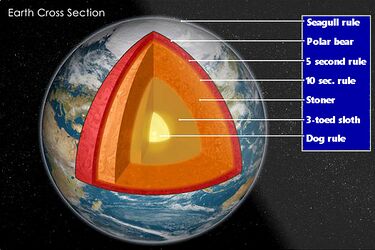Ten second rule
Originally used as a penalty in early eating competitions, the ten-second rule rose to prominence with post-WWII suburban American youth as a popular gauge of foodstuff edibility after landing on the floor.
History[edit]
The Great Paris Escargot Celebration[edit]
The first recorded implementation of the ten-second rule occurred at the Great Paris Escargot Celebration of 1888 when Pierre "Amoureaux d'Escargot" LaRue disastrously allowed a heavily buttered crustacean to slip through his fingers and onto the table in front of him. The match referee allowed him to eat the snail, but only after punishing his clumsiness with ten seconds of penalty time added to his total. The gaffe allowed Andre "Mangeur de Fruits de Mer" Goulet to win the contest. The match has been largely forgotten to history, but its legacy has endured.
Ten-second rule rises in popularity[edit]
Aristocratic society embraced the ten-second rule as a rousing joke at the dinner table. Diners who dropped food had to remain seated for ten seconds while others rose to greet dignitaries. Those who let food fall on their laps had to allow it to rest for a full ten seconds, thus staining fine dinner garments. It was a gentle but humiliating hazing among the elite.
Irish and Italian housemaids brought the ten-second rule home with them during the early 1920’s, and men quickly became enamored with the concept. While the women played by the patrician rules of the privileged and influential, men adopted a more rudimentary and carnal set of standards. If a piece of food fell from a mouth or plate, the man who dropped it had ten seconds to pick it up before someone else in the room had the right to use it as a projectile against him. The uses of the food as a tool of entertainment beyond eating lasted through the 1920s, but fell out of favor as food became scarce in the 1930s.
During the Great Depression, time restrictions were dissolved. Additionally, as soon as food became airborne, it was fair game to anybody else in the room. Contact with the floor seldom occurred during this period. During the World War II years, food dropped from mouths and plates immediately became the property of the United States. It was consequently shipped overseas to help the cause.
Competition with the five-second rule[edit]
During the 1960s, a fierce controversy arose when college students who had just discovered LSD and marijuana, noticed that the floors were dirtier than ever. Too stoned to pick up a broom and too poor to afford a vacuum cleaner, stricter guidelines were called for on the time food could remain edible after making contact with the floor. In an unlikely demand for more stringent regulations, the counterculture argued that floor conditions were so pitiful that even two seconds of contact between comestibles and low-lying surface areas could prove fatal. Conservative, cleaner members of the eating community struggled to keep the standard at the more dignified ten-second marker. Some, including a youth movement by a young Martha Stewart, insisted Congress enact a twenty-second benchmark.
The Haight Street Tragedy[edit]
On July 18th, 1967, 22 year-old transient Marcus “Moonbeam” Mantooth accidentally let a pot cookie slip from his hands. Unlike his usually methodical movements, attributed to near-constant ingestion of marijuana, Moonbeam made an acrobatic swipe to save his treat. Miraculously, he caught an edge, allowing only an incidental swipe with the carpet below. At the time regaled by friends and witnesses, Moonbeam devoured the cookie whole and enjoyed the evening. However, sometime after four in the morning, Moonbeam began complaining of stomach pains. He was later taken to a free clinic, where he contracted the meningitis that would claim his life (the stomach pains were determined to be an adverse reaction to sniffing gasoline). The senseless loss of life brought a new energy to the lower-second camp, and finally conservatives relented to halving the time under extenuating circumstances, hence giving legitimacy to the five-second rule.
Current state of the ten-second rule[edit]
While much has been done to chip away at its benchmark status, the ten-second rule remains a widely accepted norm for eating fallen victuals. Despite its reign as the status quo, the ten-second rule faces continuous pressure, both critically and legally. Lawmakers, citizens, and political actions groups continue to call for federally mandated restrictions. The Supreme Court of Tennessee recently ruled that the state government lacks the constitutional authority, nor the ability to monitor, infractions of a bill passed through the legislature to limit food/floor contact to eight seconds. It is likely that this case could come before the United States Supreme Court some time next year.
Scientific theories[edit]
While there are those who purport that the rule arose entirely devoid of hard-science support, as a pragmatic response to the desire to eat that which would otherwise make one look desperate, it would be untrue to state that scientific theories to motivate it have not been put forward. The great Count von Zinzendorf is reported to have proposed the following scientific explanation: "Ten seconds is known with a substantial degree of accuracy to be the duration of the incapacitating concussion which floor-dwelling pathogens experience when hit by a fallen foodstuff. Germs are physically incapable of climbing onto the food which just hit them for at least ten seconds, thus we can confidently declare food 'safe' until the ten seconds have passed." A known derivative issue from Zinzedorf's explanation is the question of Impact Radius, which questions the degree to which food on the ground can be temporarily de-germed by dropping new food on top of or next to it.



